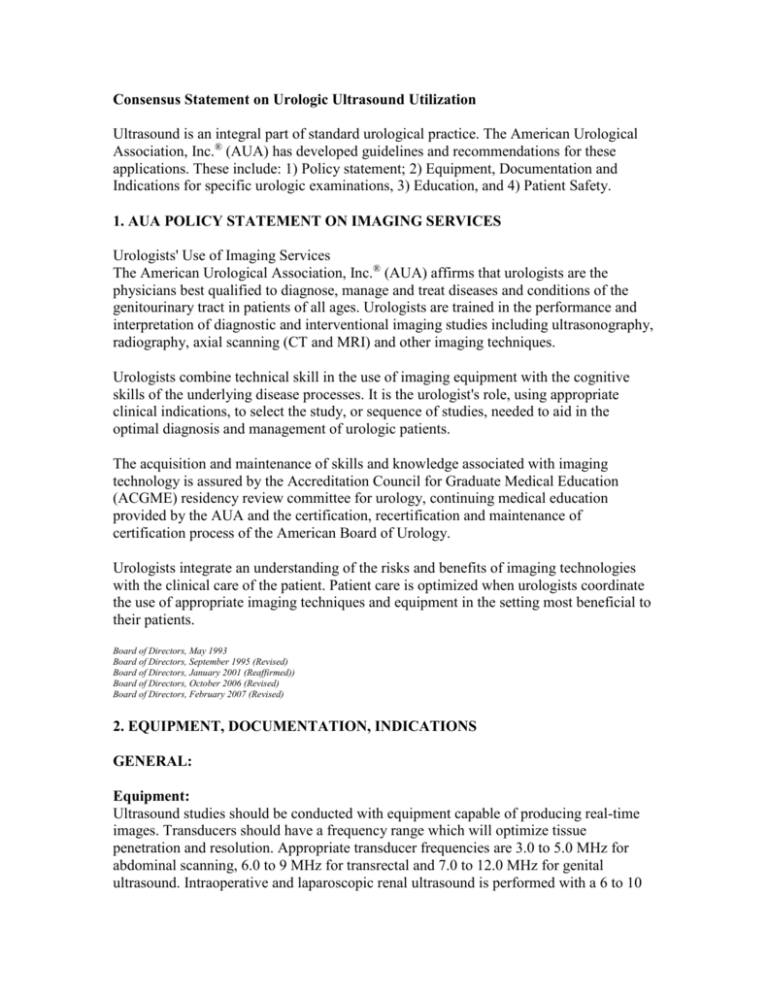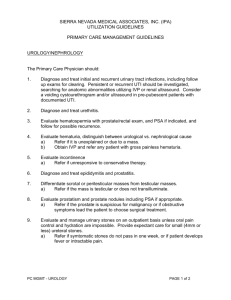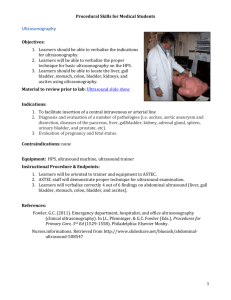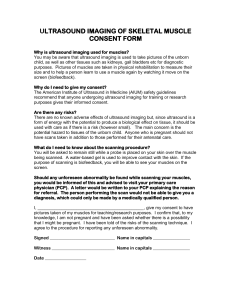Consensus Statement on Urologic Ultrasound Utilization
advertisement

Consensus Statement on Urologic Ultrasound Utilization Ultrasound is an integral part of standard urological practice. The American Urological Association, Inc.® (AUA) has developed guidelines and recommendations for these applications. These include: 1) Policy statement; 2) Equipment, Documentation and Indications for specific urologic examinations, 3) Education, and 4) Patient Safety. 1. AUA POLICY STATEMENT ON IMAGING SERVICES Urologists' Use of Imaging Services The American Urological Association, Inc.® (AUA) affirms that urologists are the physicians best qualified to diagnose, manage and treat diseases and conditions of the genitourinary tract in patients of all ages. Urologists are trained in the performance and interpretation of diagnostic and interventional imaging studies including ultrasonography, radiography, axial scanning (CT and MRI) and other imaging techniques. Urologists combine technical skill in the use of imaging equipment with the cognitive skills of the underlying disease processes. It is the urologist's role, using appropriate clinical indications, to select the study, or sequence of studies, needed to aid in the optimal diagnosis and management of urologic patients. The acquisition and maintenance of skills and knowledge associated with imaging technology is assured by the Accreditation Council for Graduate Medical Education (ACGME) residency review committee for urology, continuing medical education provided by the AUA and the certification, recertification and maintenance of certification process of the American Board of Urology. Urologists integrate an understanding of the risks and benefits of imaging technologies with the clinical care of the patient. Patient care is optimized when urologists coordinate the use of appropriate imaging techniques and equipment in the setting most beneficial to their patients. Board of Directors, May 1993 Board of Directors, September 1995 (Revised) Board of Directors, January 2001 (Reaffirmed)) Board of Directors, October 2006 (Revised) Board of Directors, February 2007 (Revised) 2. EQUIPMENT, DOCUMENTATION, INDICATIONS GENERAL: Equipment: Ultrasound studies should be conducted with equipment capable of producing real-time images. Transducers should have a frequency range which will optimize tissue penetration and resolution. Appropriate transducer frequencies are 3.0 to 5.0 MHz for abdominal scanning, 6.0 to 9 MHz for transrectal and 7.0 to 12.0 MHz for genital ultrasound. Intraoperative and laparoscopic renal ultrasound is performed with a 6 to 10 MHz linear array transducer. Transducers of higher frequency may be used for specialized exams. The equipment should display mechanical and thermal indices and provide for adjusting power output. Equipment should have software-controlled options which allow the user to obtain the highest quality image and documentation. Documentation: Appropriate images should be generated according to the type of study being performed. Images should be recorded on a permanent medium (digital format preferred) and stored in the patient's medical record. The ultrasound images should be labeled with patient identification, date of study, name of urologist, and type of probe. TRANSRECTAL IMAGING OF THE PROSTATE AND SURROUNDING STRUCTURES Equipment: A biplane or end-fire transrectal ultrasound probe should be used to evaluate the prostate and surrounding structures. Prostate size and morphology may also be evaluated using a transabdominal approach with a curved linear array probe. The transrectal probe should be able to accommodate a needle guide for transrectal ultrasound-guided biopsy. The needle guide may be a single-use device or a reusable device. The probe should have an appropriate frequency range (usually 6.0 to 9.0 MHz). Documentation/technique: The patient may be prepared by administering a cleansing enema prior to the procedure. An antibiotic may be administered if biopsy is anticipated. The prostate should be carefully scanned from base to apex in the transverse plane and from side to side in the sagittal plane. Specific abnormalities of the prostate should be documented. Surrounding structures including the bladder, seminal vesicles, ejaculatory ducts and vascular structures should be evaluated. Prostate volume should be documented and may be calculated based on measurements of the length, width and height of the prostate. The number of images obtained should be sufficient to document a complete examination and to demonstrate all significant abnormalities. Indications for transrectal ultrasound of the prostate include but are not limited to: Measurement of prostate volume Investigation of abnormal digital rectal exam Investigation of abnormal prostate-specific antigen (PSA) Prostatic assessment with sonographic directed biopsy Evaluation for and aspiration of prostate abscess Assessment for suspected congenital abnormality Evaluation of lower urinary tract symptoms - Pelvic Pain - Prostatitis/prostadynia - Obstructive and irritative voiding symptoms Evaluation of hematospermia Evaluation of infertility - Azoospermia - Low ejaculate volume or impaired semen quality To monitor cryotherapy To direct radioactive seed implantation Evaluation for local recurrence post treatment for prostate cancer Placement of fiducial markers for image-guided radiation therapy Doppler studies may be performed to identify the neurovascular bundles or demonstrate intraprostatic blood flow. RENAL ULTRASOUND Equipment: For adult abdominal scanning a curved-array transducer 3.5 to 5.0 MHz is used. For pediatric patients a higher frequency transducer may be used. Intraoperative and laparoscopic renal ultrasound will often be performed with a 6 to 10 MHz linear array transducer. Endoluminal probes of 10 to 12 MHz may be used for transureteral evaluations. Documentation/technique: Each kidney should be evaluated in the sagittal and transverse views. In the sagittal view the cortex and renal sinus should be evaluated. Comparison of the echnogenicity of the kidney with the adjacent liver and spleen should be performed when possible. Renal length and width should be obtained in the sagittal view for non-laparoscopic renal imaging. In the transverse view the kidney should be completely scanned from upper pole through the lower pole. Structures in the renal hilum should be identified. Color and power Doppler may be utilized when indicated to evaluate renal masses and blood flow in the kidney. Indications for renal ultrasound include but are not limited to: Assessment of renal and perirenal mass found on physical examination or other imaging study Assessment of dilated upper urinary tract Postoperative evaluation after renal and ureteral surgery To assess the dynamics of the upper tract effects of voiding Evaluation for and monitoring of urolithiasis Intraoperative renal parenchymal and vascular imaging for ablation or resection of masses Evaluation of hematuria in patients who are not candidates for IVP, CT or MRI. Percutaneous access to renal collecting system To guide transcutaneous renal biopsies, cyst aspiration or ablation of masses Evaluation of postoperative renal transplant patients TRANSABDOMINAL BLADDER ULTRASOUND Equipment: For adult abdominal scanning a curved array transducer 3.5 to 5.0 MHz is used. For pediatric patients a higher frequency transducer may be used. Automated equipment for measuring bladder volume may be used. Documentation/technique: A moderately filled bladder is necessary for optimal imaging of the bladder. The bladder should be scanned in the transverse and sagittal views. Bladder imaging can also be performed using using a transvaginal or transrectal approach. It may also be performed by endoluminal transurethral approach using special ultrasound transducers fitting through a standard resectoscope sheath. The bladder lumen and the bladder wall should be evaluated. Documentation of the bladder wall thickness with concomitant measurement of bladder volume may be documented. The presence of focal lesions and other abnormalities should be performed. Bladder volume may be calculated from measurements of length, width and height of the bladder. When indicated, the distal ureters may be evaluated to rule out dilation or other abnormalities. Doppler studies may be performed to evaluate ureteral jets. Indications for bladder ultrasound include but are not limited to: Measurement of bladder volume or post void residual urine volume Assess prostate size and morphology Assess for anatomic changes associated with bladder outlet obstruction Assessment of bladder neck hypermobility in women with stress incontinence Evaluation of hematuria of lower urinary tract origin To detect ureterocele in pediatric patients In the evaluation of pediatric posterior urethral valves and ureteroceles SCROTAL ULTRASOUND Equipment: Imaging of the scrotum, penis and urethra is performed with a 6 to 12 MHz linear array transducer. The length of the transducer may vary from 4 to 8 cm. Equipment with Doppler capabilities is required for demonstrating blood flow in the evaluation of torsion. Documentation/technique: The testis should be imaged in the sagittal and transverse views. The testis, epididymis and scrotal contents should be evaluated. The size and echogenicity of the testis should be documented and compared to the contralateral testis. Measurements of testicular volume should be obtained and documented. Blood flow in the testis and scrotum may be evaluated with color or power Doppler when indicated. Indications for scrotal ultrasound: Assessment of scrotal mass Painful enlargement - Epididymitis/orchitis - Testicular abscess - Torsion Non-painful enlargement - Testicular tumor - Hydrocele - Varicocele - Spermatocle/epididymal cyst - Scrotal hernia - Cyst Evaluation of scrotal trauma - Testicular rupture - Hematocele Investigation of empty/abnormal scrotal sac - Undescended testis - Thickened scrotal skin Evaluation of fertility and related issues - Varicocele - Atrophic testis - Measure size and intratesticular lesions - Microlithiasis - Impaired semen quality - Azoospermia - Antisperm antibody Follow up after scrotal surgery - Varicocele - Testis biopsy - Hydrocelectomy Follow up of patients with indeterminate scrotal masses PENILE AND URETHRAL ULTRASOUND Equipment: Imaging of the penis and urethra is performed with a linear array transducer 6 to 12 MHz. Doppler capability is necessary to evaluate penile blood flow. Documentation/technique: The penis and urethra are completely imaged in the longitudinal and transverse planes. The prevalence of plaques and scarring in the corpora cavernosum and corpora spongiosum should be documented. Evaluation of erectile dysfunction requires qualitative and quantitative measurements of blood flow in the penile arteries. Indications for penile and urethral ultrasound Include but are not limited to: Evaluation for erectile dysfunction Documentation of intracorporal fibrosis Assessment of penile trauma or pain Localization of foreign body Evaluation of anterior urethral stricture Evaluation of urethral diverticulum DOPPLER STUDIES IN UROLOGY Equipment: Doppler studies can be done both alone (spectral Doppler) and in combination with realtime imaging (duplex Doppler and color-flow Doppler studies). These studies are indicated to evaluate urologic organs for normal and abnormal blood flow. Indications for Doppler ultrasound include but are not limited to: Evaluate blood flow patterns in urologic organs Evaluate varicocele Evaluate for torsion, trauma, infection Evaluation of erectile dysfunction Post renal transplant evaluation for vascular flow Evaluation of complex renal masses 3. EDUCATIONAL REQUIREMENTS Appropriate training is essential for the performance and interpretation of ultrasound examinations. Such training involves physicians in two categories: 1) Urology residents in training programs and 2) Urologists whose residencies have been completed and who are in practice. Urologists in both categories receive ongoing instruction in imaging as part of a program of continuing medical education and through the certification, recertification and maintenance of certification cycle. Ultrasound training in Residency Review Committee (RRC) approved urology programs: Urology training programs are accredited by the Residency Review Committee (RRC) of the Accreditation Council for Graduate Medical Education (ACGME). The fifth edition (2001) of the Objectives for Urology Residency Education, Part III Radiologic Evaluation and Treatment, developed by the Society of University Urologists includes guidelines prepared on ultrasound of the genitourinary system. These guidelines join those of other residency programs, such as ophthalmology, obstetrics and gynecology, and radiology in incorporating some degree of ultrasonography training in their recommendations. The guidelines for urologic training incorporate specific areas including: 1. The physical principles of ultrasonography; 2. Sonographic artifacts and methods of overcoming them; 3. The biomedical effects of ultrasound with regard to safety; 4. Information about the various types of ultrasound equipment available, with emphasis on the special attributes of each for the organ to be imaged. 5. The technique of producing an examination of high technical quality and reproducibility; 6. Urogenital organ anatomy, both normal and abnormal, as seen sonographically, encompassing benign and malignant conditions; 7. Methods of written and visual documentation and report of the examination; 8. Understanding the indications for and an ability to interpret the examination; 9. The technique and indications for organ biopsy under sonographic guidance; 10. Technique and indications for intraoperative access to the renal collecting system and therapeutic, ablation or resection of tumors. 11. For program accreditation, the Residency Review Committee for Urology requires ultrasound training in both the performance and interpretation of ultrasound examination. This information is imparted in didactic teaching sessions and by hands-on experience. The equipment for sonographic examination is as readily available to the resident as is a cystoscope. The equipment must be readily available to the resident without any impediments that would discourage its use. The equipment should be located within the urology clinic. Residents should begin to use this modality very early in their training and continue to work with it throughout the period of residency, so that its use is a naturally incorporated part of patient evaluation and examination. A cooperative effort between urologists and radiologists has proven to be an effective training methodology. The participation by urology residents should not solely be that of trying to interpret studies based on static films produced by technical personnel, but includes active instruction and participation in the performance and interpretation of the studies in real time. Included instruction should be the technique of biopsy of the urogenital organs under ultrasonic guidance when appropriate. Instruction should include the use of ultrasound to guide intraoperative therapy of urologic diseases. Assessment of the adequacy of resident training is carried out as part of the examination for certification, recertification, and maintenance of certification by the American Board of Urology. Post-residency training: The AUA Office of Education has provided a wide variety of continuing medical educational opportunities dealing with ultrasonography for over a decade. These programs have covered all of the areas discussed under the residency training section. The educational formats include seminars, hands-on and eyes-on sessions, with an emphasis on skills acquisition and verification. Through these educational opportunities, these urologists are today performing ultrasonography of the urogenital system competently, safely and with proper clinical indications. An additional educational supplement is a large library of educational materials (print and video) on many aspects of ultrasonography of the urogenital system, available from the AUA. Certification, recertification, maintenance of certification and continuing medical education (CME): In 1985 the American Board of Urology instituted 10-year certificates and have required recertification after this period. The certification and recertification process (written examinations, pathology and imaging examination, oral examination, peer review, review of practice logs) thoroughly examines the subject of ultrasonography, an integral component of the specialty of urology. Recertification requires continuing medical education activity. Beginning in 2007, individuals who are certified or recertified will enter into the Maintenance of Certification process, and will be further examined on ultrasonography, and will have their practice reviewed as often as every two years. It is recognized that the field of ultrasonography is changing rapidly with the development of improved instrumentation and expanding clinical indications. Urologists are continually exposed to these developments in published articles in the Journal of Urology, AUA News and other publications. The AUA regularly sponsors postgraduate courses and instructional courses at its annual meeting and at various sites throughout the year. These courses include hands-on opportunities with skills verification. Papers and reports on ultrasonography related to urology are presented at the meeting on a regular basis. 4. PATIENT SAFETY Ultrasound procedures should be performed for the appropriate indications. Urologists are encouraged to adhere to the principles of A.L.A.R.A. (as low as reasonably acceptable) to minimize patient exposure to acoustic energy. Probes and equipment should be maintained and inspected per manufacturer's requirements. Probe cleaning and sterilization should follow CDC guidelines for levels of sterilization of devices. Board of Directors, January 1987 Board of Directors, September 1988 (Revised) Board of Directors, September 1990 (Revised) Board of Directors, January 1995 (Revised) Board of Directors, April 1995 (Revised) Board of Directors, January 1996 (Revised) Board of Directors, October 1996 (Revised) Board of Directors, January 2002 (Reaffirmed) Board of Directors, February 2007 (Revised)







![Jiye Jin-2014[1].3.17](http://s2.studylib.net/store/data/005485437_1-38483f116d2f44a767f9ba4fa894c894-300x300.png)
